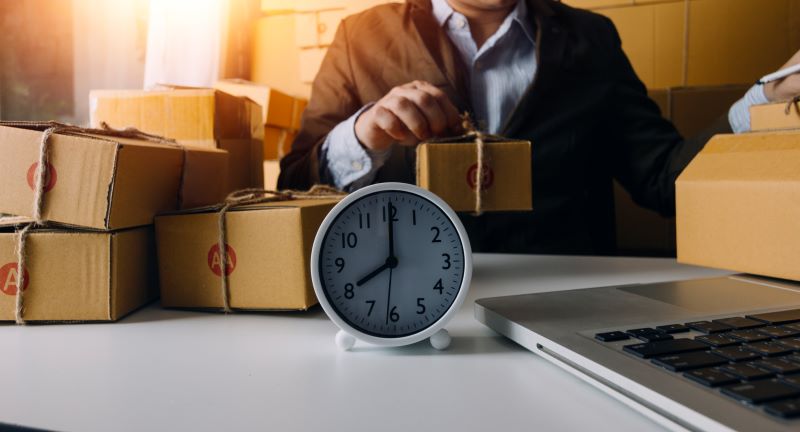Customs clearance processes are official procedures applied during the transit of goods and services from one country to another. These processes are carried out to regulate, tax, audit and monitor trade. In general, customs procedures consist of a series of steps and the process may vary depending on various factors. Custom processing times may vary depending on these variables.

Customs processing times include the following steps:
Declaration Preparation (Predetermined Time): Declaration preparation in customs procedures means making an official declaration so that the goods or services can be subjected to the customs clearance process in international trade. This process is the first step taken to initiate customs clearance and is carried out within a certain period.
The details of the customs declaration preparation process are as follows:
- Determining the Quality and Quantity of Trade: The first step is to determine the quality and quantity of the goods or services to be exported or imported. This process ensures that accurate and complete information is included in the customs declaration.
- Collection of Relevant Documents: Documents required for declaration preparation are collected. These documents include invoice, transport document, certificate of origin, insurance policy and other relevant documents.
- Filling out the Customs Declaration Form: A customs declaration form is an official document in which the exporter or importer reports details about the goods or services to the customs authorities. This form contains information such as the type, quantity, value and country of origin of the goods.
- Determination of Customs Tariff Position: The basis of the Harmonized System is a 6-digit coding system. The first two digits of this 6-digit code indicate which chapter the item is in. The second two digits indicate which group the goods are in in that chapter. The first four digits are called the "tariff position of the goods" in the Harmonized System. This ensures the correct classification of the goods and the correct calculation of customs duties.
- Getting Export or Import Permits: Special permits may be required for the export or import of certain products. These permits must be got during the customs declaration preparation process.
- Use of Electronic Customs Systems: In many countries, the customs declaration process is carried out electronically. The declaration is filled out through the relevant electronic systems and forwarded to the customs authorities such as custom brokers and custom officers.
- Preliminary Examination and Checks: The customs declaration may be examined in advance and may encounter checks. These checks are carried out to ensure the safety, suitability and accuracy of the goods.
- Signing the Declaration and Approval: After the customs declaration is prepared, it is signed and approved by the exporter or importer. This means verifying the accuracy of the declaration.
- Updates During the Process: When any changes or updates are required during the customs declaration process, the relevant documents are corrected and notified to the customs authorities.
Preparation of Documents (Predetermined Time):
Customs procedures, an indispensable part of international trade, include official procedures carried out during the transportation of goods or services from one country to another. The documents used in this process must be prepared accurately and completely. Here is a step-by-step description of the process of preparing documents for customs clearance:
Commercial Invoice
One of the most important documents that form the basis of the customs declaration is the commercial invoice. This document should contain basic information such as the type of goods or services, quantity, value, buyer and seller information. The commercial invoice is the main reference point for calculating customs duties and taxes.
Transportation Document (Bill of Lading or Airway Bill):
Depending on the transportation method of the goods, transportation documents such as Bill of Lading (sea transportation) or Airway Bill (air transportation) are issued. These documents are used during the transportation of the goods and contain the details of the transport vehicle on which the goods are transported.
- Certificate of Origin: Certificate of origin is a document indicating the country where the goods were produced or processed. For goods and services subject to free trade agreements between some countries, a certificate of origin can help reduce customs duties or provide exemptions.
- Insurance Policy: The insurance policy containing details of the insurance against risks that may occur during the transportation of the goods must be included in the customs declaration. This document provides assurance against damages that may occur during the transportation of the goods.
- Other Documents: Depending on the goods or services in question, additional documents such as special permits, health certificates, documents specifying special labeling requirements must also be prepared. These documents are used to verify that the goods comply with specific conditions.
Customs Declaration Submission (On a Particular Day)
The exporter or importer submits the customs declaration to the competent customs authorities. Declaration is the first step required to start customs procedures.
Customs Inspection and Evaluation (On a Particular Day)
Customs authorities check the accuracy of the goods by examining the information in the declaration. If necessary, physical inspection of the goods or requesting additional documents may extend the process.
Payment of Customs Duty and Other Fees (On a Particular Day)
Taxes, duties or other fees arising during customs procedures are paid. Making payments on time helps the process go faster.
Customs Clearance Completion and Release (On a Specific Day)
Once all inspections and payments are completed, the goods are released and allowed to enter or exit the country.
HRA Global Logistics offers services covering all customs clearance processes for its customers. Contact our customer representatives to get more information about these services. Our team will be happy to answer your questions.
